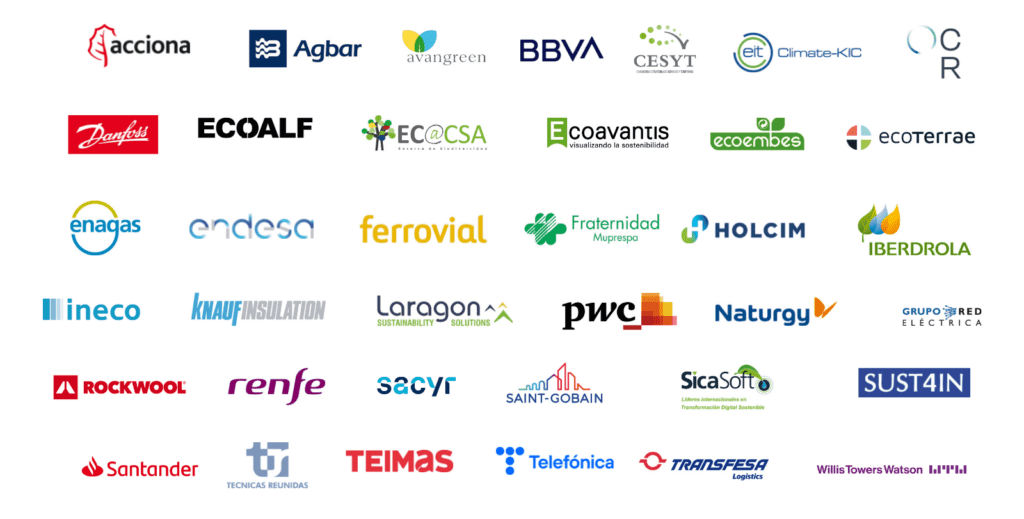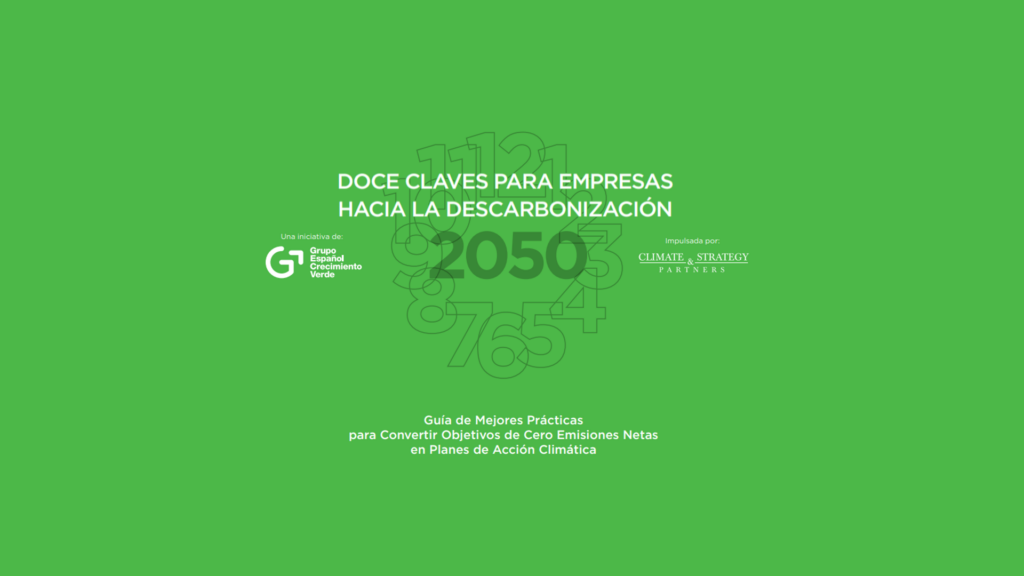The Spanish Green Growth Group (GECV) presented the guide «12 Key Steps for Companies Delivering Net-Zero Emissions» on 2 November in Glasgow, coinciding with COP26.
- The guide compiles in a dozen recommendations best practices to facilitate a more robust, effective, and realistic approach for companies to achieve their net zero emissions targets by 2050 in alignment with the Paris Agreement and the UN SDGs.
The Spanish Green Growth Group (GECV) presented the guide “«12 Key Steps for Companies Delivering Net-Zero Emissions»“, on 2 November in Glasgow, coinciding with COP26.
The guide compiles in a dozen recommendations best practices to facilitate a more robust, effective, and realistic approach for companies to achieve their net zero emissions targets by 2050 in alignment with the Paris Agreement and the UN SDGs.
The development of this guide available in Spanish and English has been driven by Climate Strategy & Partners,and brought together the expertise of professionals from 37 GECV member companies,and we have had the pleasure of participating in it.
The event was addressed by Ms. Valvanera Ulargui General Director of the Spanish Climate Change Office (OECC) Andrés Landerretche(COP25 Presidency Coordinator) Hazel Gulliver (Engagement Director at ScottishPower), Gonzalo Sáenz de Miera (GECV Vice-President), Carmen Navarro (GECV Manager), Peter Sweatman (Executive Director of Climate Strategy & Partners and technical leader in the development of the Guide) and several members of the GECV: Antoni Ballabriga (Global Director of Responsible Business at BBVA), Kirsten Dunlop (CEO of Climate-KIC), Maya Ormazábal (Environment and Human Rights Director at Telefónica) and Nuria Rodríguez Peinado (Environment and CSR Director at Naturgy).
Science-based reduction plans and short- medium- and long-term goals
The paper’s most novel recommendations are to set short, medium, and long-term emissions reduction targets towards emissions neutrality by 2050 or sooner, based on science and aligned with the 1.5-degree target of the Paris Agreement. These targets should be accompanied by sectoral roadmaps outlining actions to be taken in the short and medium term to decarbonise the company, including investment and financing policies aligned with the European Taxonomy and carbon pricing.
Finally, the guide highlights a few practices for implementing a more robust, inclusive, and transparent governance framework in which the role of corporate governance bodies and shareholders in the approval and implementation of the plan, the disclosure of the plan and the evaluation of its results in line with international standards, and the alignment of public affairs activities with the goal of zero net emissions by 2050 are paramount.
The main strength of the document is that it is the result of an exhaustive work conducted over several months by professionals from companies of varied sizes and profiles: multinationals, innovative SMEs, sustainability consultancies, financial institutions, etc… It is also a practical guide synthesised in twelve recommendations, which facilitates its implementation in the corporate climate action plans now underway and of course in those to come.
«Twelve key steps for companies delivering Net-Zero Emissions»
- “Maximize certainty for investors and society by includingshort, medium and long term quantitative targets(reviewed periodically at least every 5 years) for the reduction of GHG emissions, based on science (“ScienceBased Targets”), and aligned with the 1.5º goal. These targets should cover Scopes 1, 2 and 3 of the entire organization’s emissions (taking into account the 15 categories from the GHG Protocol that are material and relevant for the organisation) and have as a final goal the neutrality of GHG emissions by 2050, or before. The use of offsets, emissions credits or an excessive reliance on negative emissions technologies (carbon capture, utilization and storage) should be limited.”
- “Develop decarbonisation roadmaps, for each relevant sector for the company/financial institution considering its materiality, that identify and describe the actions that will be carried out to successfully deliver the stated reduction targets. These short-, medium- and long-term actions should be realistic and relevant. They should not pose a significant harm to biodiversity, circular economy, water and marine resources and pollution (strategies on these matters can be annexed to the climate plan over time), and should enable the organisation to quantify the results of its efforts within a given timeframe”
- “Sectoral roadmaps must include Quantitative financial projections and evaluations of the financial viabilityof the Plan through, for example, cost estimates, thus showing how the organization’s business will be compatible with an emission-neutral economy in accordance with the Paris Agreement and in the face of a just transition. For those sectors eligible under the European Taxonomy, the sectoral roadmaps must describe how the organization’s business model and its products or services are aligned with the Taxonomy,that they do not aggravate environmental damage, and dispose of products, services and /or practices that do significant harm.”
- ” Financial institutionsshould align with objetivos de reducción específicos a cada sector, sector-specific reduction targets, prioritizing high-emitting sectors in accordance with the international standards (such as TCFD and UNEP FI), and develop realistic decarbonisation roadmaps to successfully address the reduction targets over a minimum horizon of 10 years. These sector roadmaps should include policies to limit financing towards activities not aligned with the EU Taxonomy and eliminate financing of activities that jeopardize the fulfilment of the Paris Agreement objectives,with milestones in the short and medium term. Finally, the plan will include objectives to increase green finance and investments aligned with the EU Taxonomy as a complement to, and not a substitute for, the emissions reduction targets.”
- “The Climate Action Planwill also include the following key elements per relevant sector for the company/financial institution: A description of the analysis and management of climate risks(physical and transition risks) and opportunities created by acting on climate change; an analysis of climate scenarios based on international standards (NGFS, IPCC and IEA); carbon pricing mechanisms (both a shadow carbon price and an internal carbon tax) that cover the entire organisation and its activities; measures for the future allocation of capital expenditure (CapEx) coherent with the organisation’s decarbonisation pathway towards the 1.5º goal and aligned with the EU Taxonomy, as well as the methodologies used to develop such measures and key performance indicators; and principles to advance sustainable finance objectives.”
- “Create a transparent and inclusive process to develop, implement, inform, disclose and review the Climate Action Plan. The plan should describe the methodology used for its development and implementation, with the subsequent dissemination of this methodology as an essential step. The plan should also disclose the significant climate information and assumptions that have been taken into consideration in this process following the practices established by SASB, TCFD, GRI, CDP and the European Commission Guidelines, in accordance with the Spanish Código de Comercio recommendations (for Spanish entities), and especially including all the Scopes of emissions (1, 2 and 3), double materiality perspective, and the identified key performance indicators”
- “Develop regular assessments of the Climate Action Plan, with upward revisions that reflect the latest climate science and technological advances. Evaluations should be based on quantitative key performance indicators. Financial institutions will implement protocols to monitor and report annually their portfolios alignment with their reduction targets, climate scenarios, and their trajectories analysed (including those towards 1.5º) using science-based methodologies, such as PACTA and SDA.”
- “Climate Action Plans must include goals and actions for climate adaptation based on the principles to develop National Adaptation Plans and the content of the EU Taxonomy delegated act on climate adaptation. In this, as in everything, a broad base approach will be taken that covers all relevant sectors for the organization’s activities, addressing economic, social and environmental problems promoting a just transition to a decarbonized economy together with the corresponding appropriate legislative reforms.”
- “All public affairs activities and publicprivate partnerships must be grounded in the Climate Action Plan and aligned with the Paris Agreement. Of particular importance is that the organization’s advocacy position and its direct and indirect advocacy activities, including its participation in trade associations, are aligned with its emissions reduction targets. The Plan must transparently identify and disclose all such advocacy positions and activities as well as include regular evaluations of these”
- “Recognize that climate change is a risk for the entire economy and for the industrial and financial sectors, and in particular for vulnerable groups. The Climate Action Plan must include an analysis of the impact of the organization’s transitiontowards a carbon neutral model on its workers and relevant communities in order to ensure ajust transition“
- “The Climate Action Plan must be approved by the company’s principal governing body ,which will also guarantee and monitor its proper development and implementation , with one of its members specifically responsible for the organization’s climate actions. It is also recommended that a subcommittee is established to support the Plan’s oversight in detail. In addition, the remuneration of the indicated body must be linked to the performance and achievement of the Plan’s emissions reduction targets.”
- ““Publish the Climate Action Plan an submit it to a vote at the annual shareholders meeting to ensure shareholder support for the Plan.”
An opportunity for all for a robust framework for climate action
Gonzalo Saénz de Miera, vice-president of the GECV, pointed out in his speech that “«the reduction of emissions must be perceived as a task for everyone, citizens, public administrations and also companies, and climate action plans must always be seen as an opportunity and backed by a robust framework for action”. In addition, he invited companies from Spain, Latin America and all over the world to make this guide their own and to send them their impressions to continue improving it in the future.





